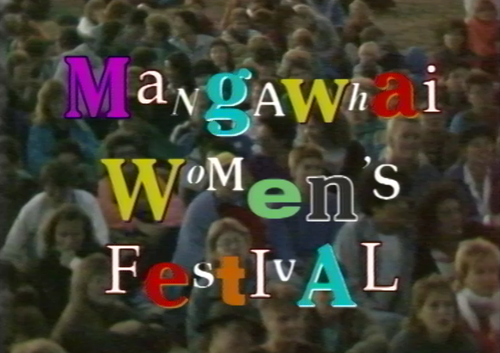
Hero image: Screengrab from Mangawhai Women’s Festival, Collection reference F2613.
The Mangawhai Women’s Festival was held in February 1987. It was an outdoor festival for women and children only and was attended by more than 1,800 people. Pat Rosier wrote a review of the festival in Broadsheet and described how the crowds flocked to enjoy “the music, the stalls, the workshops, the beach (a good walk, but well worth the effort), the other women.”
Raylene Beals, a Digital Workflow Archivist at Ngā Taonga recently preserved the official recording of the Festival. “It was incredibly empowering as an archivist and as a performer to see this and work on it,” she says. “There was so much passion involved to put it together.”
In the film, festival organiser Liz Lovell-Smith explains how she got some friends together (fellow organisers Sandy Morris, Phillis Comerford, Kara Dodson and Jenny Renalls), printed some posters and ‘got a festival’ – just like that. “It was huge in terms of the number of people who went and that it was a women only crew,” reflects Beals. “It seemed full on!”
Many of the crew were new to organising and building a festival. A few experienced carpenters and engineers taught the rest of the crew and then there was months of mucking in – grubbing out gorse, building the stage, designing the scaffolding, sorting the water supply, PR and publicity. Almost everything onsite for the festival was built from scratch.
Directed by Fiona Niccol, the video captures the music and crowds well. Positive female energy was a focus mentioned by many women interviewed. Toward the end of the film, Sharon Hawke appears – she and her friends appreciated how the Pākehā crew had interacted and engaged with tangata whenua.
“It looked like a great festival,” says Beals. “The bands in the recording were all fantastic and there were some great names.” Too right: Putty In Her Hands, Women of the Hokianga, Out of the Compost, Let Your Hair Down and Dead Famous People all played among many others.
As well as the content, Beals enjoyed working with the 1-inch tape that the master material was held on. “I love 1-inch. It’s reel-to-reel video that came out in 1976 – the same year I was born. It’s really tactile for me as an archivist as I have to thread it through the reel-to-reel machine. The machine is like starting an old car – I love hearing the hum it makes.”
After making a digital copy, the open source program QC Tools is used to quality-check the recording. It was then uploaded to the online catalogue. “It’s great that people can see this now,” says Beals. “One of my heroes Mahinārangi Tocker was in this – seeing her perform was just magic. All the bands were fantastic. So much work went in to this Festival. That’s why people need to watch this: to see what went in.”